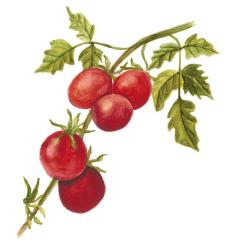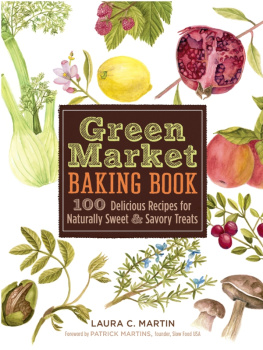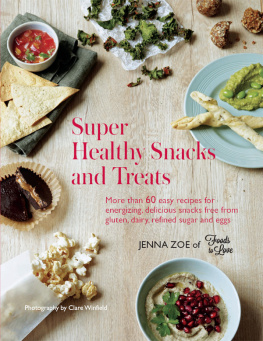
Green
Market
BAKING BOOK
100 Delicious Recipes for
Naturally Sweet & Savory Treats
LAURA C. MARTIN
with Annie Stilwell Burch and Cameron McCord
Illustrations by Laura C. Martin
Foreword by PATRICK MARTINS, founder, Slow Food USA

Recipes for reprinted from
The Great American Detox Diet by Alexandra Jamieson.
Copyright 2005 by Alexandra Jamieson.
Permission granted by Rodale, Inc., Emmaus, PA 18098.
reprinted from Native Peoples magazine.
Permission granted by Beverly Cox.
reprinted from Basil: An Herb Lovers Guide by Thomas Debaggio and Susan Belsinger, published by Interweave Press, 1996. Permission granted by authors.
reprinted from Herbs in the Kitchen by Carolyn Dille and Susan Belsinger, published by Interweave Press, 1991. Permission granted by authors.
). Permission granted by author.
STERLING and the distinctive Sterling logo are registered trademarks of Sterling Publishing Co., Inc.
Library of Congress Cataloging-in-Publication Data Available
10 9 8 7 6 5 4 3 2 1
Published by Sterling Publishing Co., Inc.
387 Park Avenue South, New York, NY 10016
2011 by Laura C. Martin
Distributed in Canada by Sterling Publishing
c/o Canadian Manda Group, 165 Dufferin Street
Toronto, Ontario, Canada M6K 3H6
Distributed in the United Kingdom by GMC Distribution Services
Castle Place, 166 High Street, Lewes, East Sussex, England BN7 1XU
Distributed in Australia by Capricorn Link (Australia) Pty. Ltd.
P.O. Box 704, Windsor, NSW 2756, Australia
Printed in China
All rights reserved
Sterling ISBN 978-1-4027-5997-0
For information about custom editions, special sales, premium and corporate purchases, please contact Sterling Special Sales Department at 800-805-5489 or specialsales@sterlingpublishing.com.
To our family,
especially Jack, Michael, and Andy
Contents

Foreword by Patrick Martins, Founder, Slow Food USA


EVER SINCE THE EIGHTEENTH CENTURY, TO BE SLOW WAS TO OBSTRUCT progress and civilization. Natures secrets were unlocked and we discovered her quicksilver side: electricity, the speed of light, the incomprehensible whirl of subatomic particles. We built our modern society upon the assumption that speed is equivalent to efficiency and that efficiency is equivalent to saving time, as if seconds can be hoarded and spent later. Progress was good. Faster was better.
Thanks in part to the Slow Food movement, our culture has reevaluated the implications of slow. Now taking time can be as worthwhile as saving it, whether seeking out a small business that specializes in a craft or baking a pie with family and friends using fruits from the local farmers market. Without challenging its value, we now recognize a more sophisticated understanding of efficiency. It is an understanding that, perhaps unsurprisingly, restores our respect for natural rhythms.
The fast-faster-fastest emphasis of commodity culture, coupled with the relentlessness of globalization, fills our world with both frenzy and glut. Many companies have moved faster than their ability to produce decent products. Witness 2007, the Year of the Recall. Factory farming, mad cow disease, and E. coli spread when reckless speed and profit-seeking trumped sounder, but slower, values. When consumers are dying and the environment is being ravished, when workers rights are compromised and community bonds are dissolvingall as a consequence of our fast-faster-fastest method of doing businessthe results can hardly be construed as efficient for our society as a whole.
The traditions and simplicity of growing and eating food in time-tested ways have become a mere memory. The fast-faster-fastest mentality is marked by ignoring the qualities people cherish most in order to promote those aspects of a commodity that make it more valuable to store, ship, and sell. Simply proposing an alternative to the global economy will not workglobal alternatives are abstract figments. The only true alternatives are those that exist within the domain of personal choice. Business practice conforms to the international economy that has emerged like a constellation from the accumulation of millions of personal choices made across the planet every day. The only way we can create change is to work within that economy, and the only way we will succeed in influencing personal choices is by influencing the value system people draw upon when making those choices.
Laura Martins book describes in great and delicious detail a choice that is very different from those proposed by the worlds richest food companies. The proliferation of artificial sweeteners, processed chemicals, and high levels of refined sugars in store-bought food is a tragic circumstance sanctioned by those in power, one that has turned this generation into the first ever to not live longer than the one that preceded it. The answer to satisfying your sweet tooth without poisoning your body is to use local and seasonal fruits, vegetables, and herbs, along with whole grains and natural sweeteners. By eating like this, your destiny is in your hands, and the result is a healthier body, a healthier environment, and healthier local food communities.
Sweets are the very definition of pleasure, and taking the time to bake with family and friends is a way of prolonging that pleasure. I assure you that you will love reading and making the recipes in this book, from Chef Linton Hopkinss honey whole wheat or rosemary olive breads, to Alice Waterss famous whole wheat waffles.
The fast-faster-fastest business of commodities makes similar, but lesser, versions of products and charges little for them, burying the true cost of their charade in a tab that they expect societyand the environmentto pay. By reading this book you will support a virtuous production system, include a little sweetness in your life, and find great recipes that you wont have to pay for later.
Patrick Martins, founder, Slow Food USA

THE IDEA FOR THIS BOOK BEGAN WITH THE MOST ANCIENT OF ALL experiencesa family sharing a meal together. The slow food bug bit our large, complicated family and were enthusiastic about eating things that are locally grown. An excursion to the local farmers market became one of the highlights of our week.
The meals we fixed from the treasures we found were fabulous, but there was always something missing. After a feast of green beans, fresh corn on the cob, heirloom tomatoes, yellow squash, fried okra, and eggplant, we congratulated ourselves on being locavores and eating a meal completely locally grown. Then someone asked about dessert. Silence. Blueberry pie, someone suggested. No, sugar isnt local! Raspberry sorbet? Same answer. Peach cobbler? Oatmeal cookies? Blackberry tart? Same answer. Isnt there anything a little more decadent than just locally grown fruit that we can have for dessert?
Next page















